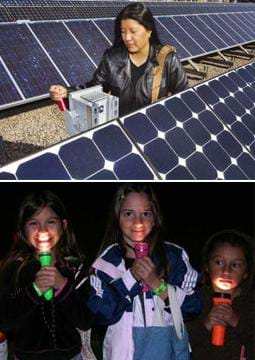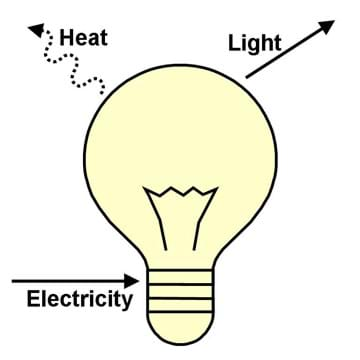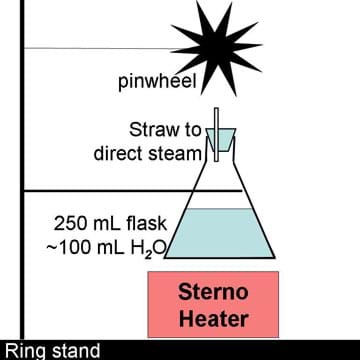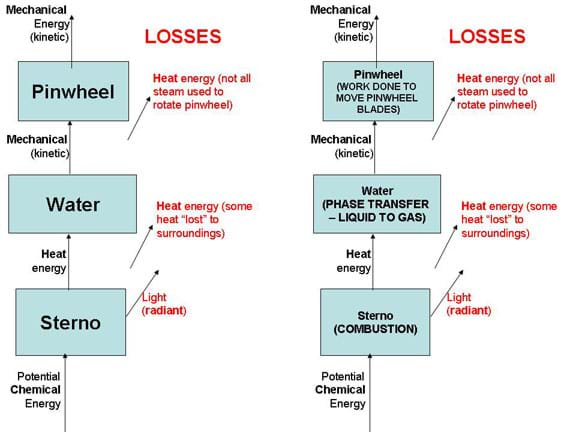Quick Look
Grade Level: 8 (6-8)
Time Required: 45 minutes
Expendable Cost/Group: US $1.00 Add note: This activity also requires some non-expendable items; see the Materials List for details.
Group Size: 3
Activity Dependency:
Subject Areas: Physical Science, Science and Technology
NGSS Performance Expectations:

| MS-PS3-5 |
Summary
Students evaluate various everyday energy conversion devices and draw block flow diagrams to show the forms and states of energy into and out of the device. They also identify the forms of energy that are useful and the desired output of the device as well as the forms that are not useful for the intended use of the item. This can be used to lead into the law of conservation of energy and efficiency. The student activity is preceded by a demonstration of a more complicated system to convert chemical energy to heat energy to mechanical energy. Drawing the block energy conversion diagram for this system models the activity that the students then do themselves for other simpler systems.
Engineering Connection
Energy exists in many forms all around us. Engineers have determined how to capture and release that energy in forms that are most useful to create heat where required and the work done in many engineered devices. Process flow charts that show the inflow and outflow of energy through a process are a tool that engineers use to help design and evaluate different systems and processes.
Learning Objectives
After this activity, students should be able to:
- Describe at least three examples of how energy is converted from one form to another.
- Demonstrate and diagram the conversion of energy into usable forms using a flowchart.
- State the law of conservation of energy.
- Identify seven forms and two states of energy.
- Identify the forms and states of energy in everyday items as we use them to do useful energy.
Educational Standards
Each TeachEngineering lesson or activity is correlated to one or more K-12 science,
technology, engineering or math (STEM) educational standards.
All 100,000+ K-12 STEM standards covered in TeachEngineering are collected, maintained and packaged by the Achievement Standards Network (ASN),
a project of D2L (www.achievementstandards.org).
In the ASN, standards are hierarchically structured: first by source; e.g., by state; within source by type; e.g., science or mathematics;
within type by subtype, then by grade, etc.
Each TeachEngineering lesson or activity is correlated to one or more K-12 science, technology, engineering or math (STEM) educational standards.
All 100,000+ K-12 STEM standards covered in TeachEngineering are collected, maintained and packaged by the Achievement Standards Network (ASN), a project of D2L (www.achievementstandards.org).
In the ASN, standards are hierarchically structured: first by source; e.g., by state; within source by type; e.g., science or mathematics; within type by subtype, then by grade, etc.
NGSS: Next Generation Science Standards - Science
| NGSS Performance Expectation | ||
|---|---|---|
|
MS-PS3-5. Construct, use, and present arguments to support the claim that when the kinetic energy of an object changes, energy is transferred to or from the object. (Grades 6 - 8) Do you agree with this alignment? |
||
| Click to view other curriculum aligned to this Performance Expectation | ||
| This activity focuses on the following Three Dimensional Learning aspects of NGSS: | ||
| Science & Engineering Practices | Disciplinary Core Ideas | Crosscutting Concepts |
| Construct, use, and present oral and written arguments supported by empirical evidence and scientific reasoning to support or refute an explanation or a model for a phenomenon. Alignment agreement: Science knowledge is based upon logical and conceptual connections between evidence and explanations.Alignment agreement: | When the motion energy of an object changes, there is inevitably some other change in energy at the same time. Alignment agreement: | Energy may take different forms (e.g. energy in fields, thermal energy, energy of motion). Alignment agreement: |
International Technology and Engineering Educators Association - Technology
-
Energy is the capacity to do work.
(Grades
6 -
8)
More Details
Do you agree with this alignment?
-
Illustrate how systems thinking involves considering relationships between every part, as well as how the system interacts with the environment in which it is used.
(Grades
6 -
8)
More Details
Do you agree with this alignment?
State Standards
National Science Education Standards - Science
-
Energy is a property of many substances and is associated with heat, light, electricity, mechanical motion, sound, nuclei, and the nature of a chemical. Energy is transferred in many ways.
(Grades
5 -
8)
More Details
Do you agree with this alignment?
-
Electrical circuits provide a means of transferring electrical energy when heat, light, sound, and chemical changes are produced.
(Grades
5 -
8)
More Details
Do you agree with this alignment?
-
In most chemical and nuclear reactions, energy is transferred into or out of a system. Heat, light, mechanical motion, or electricity might all be involved in such transfers.
(Grades
5 -
8)
More Details
Do you agree with this alignment?
New York - Science
-
Construct, use, and present an argument to support the claim that when work is done on or by a system, the energy of the system changes as energy is transferred to or from the system.
(Grades
6 -
8)
More Details
Do you agree with this alignment?
Materials List
For the combustion demo:
- sterno or other heating source
- 250 ml erlemeyer flask with a 1-hole stopper
- pre-heated water (near boiling) in a thermos
- ring stand to hold pinwheel and flask above heating source
- pinwheel
- various electrical, mechanical or battery-operated devices (one per group); examples: battery-operated flashlight, shaking flashlight, light-solar panel-LEGO motor set-up, personal heat packet, Genecon generator, hairdryer, glow stick
- Energy Conversion Student Worksheet
Worksheets and Attachments
Visit [www.teachengineering.org/activities/view/cla_activity2_energy_conversion] to print or download.Introduction/Motivation

Energy exists in many forms all around us. The development of our modern society has been accomplished because scientists and engineers have learned to capture some of that energy and transform it into ways to do useful work. The conversion of energy from a chunk of coal into steam and then into mechanical engines that could do heavy work was a critically important role of engineers in the 19th century that helped to start the industrial revolution. An engineer needs to know where to "find" energy resources and then how to convert them into forms that are more useful for all of the machines and gadgets we use in our daily lives.
The law of conservation of energy states: Energy can neither be created nor destroyed... But, it can be converted! (Relate back to the energy forms and energy flow diagrams discussed earlier. In some cases, the items had different starting and ending energy forms, so conversions were going on.) The truck was an example of chemical energy converted to mechanical and heat through the COMBUSTION of fuel.
Energy conversions are necessary when we desire a certain form or state of energy, perhaps heat for our homoes, when the only form available is different, perhaps chemical energy in fuel. Conversions are also useful for transporting energy to where it is needed. For example a hydropower plant may be miles from our homes, so how do we use its energy? We convert its mechanical energy (flowing water) to electric energy, which is easily transported to our home via wires, and then back to mechanical energy in our blenders.
(Next, conduct the combustion demo to illustrate how we can add conversion processes to our energy flow diagrams.)
Procedure
Before the Activity:

- Set up the various energy conversion devices around the classroom. They do not need to be plugged in as long as they are familiar to students.
- Make copies of the Energy Conversion Student Worksheet.
- Pre-heat the water to near boiling point to speed up the combustion demo and store in a thermos or other insulated container.
- Set up the combustion demonstration (see Figure 1).
With the Students
After the Introduction:
- Start the combustion demo by transferring water to flask and lighting the Sterno. Explain the system and that it represents components of a fossil fuel power plant.
- Draw energy flow diagrams starting with various forms of energy. Expect students to be able to help define the energy forms and states.
- We already know about forms of energy in this process (on left of block diagram), now let's define the conversion processes (see added words on right). This model is similar to a coal fired power plant, which would have one more step: the steam would rotate a turbine that has magnets and coils of copper wire. The moving magnetic field causes electrons in the copper to wiggle, thereby creating an electric potential (voltage).

Block diagrams for combustion demonstration.
Discussion Questions
- Who knows what important process is happening between the different forms of energy? State that this conversion is something we use today. Relate it to our use of fossil fuels and the specific combustion process.
- Make sure students understand that energy "losses" occur (energy is converted to an undesired form) as energy is converted from one form to the next.
- Explain that we can model many different energy conversions in household appliances.
Student Activity:
- Hand out the worksheets and explain that students will now do the same diagramming for several common appliances.
- Have students look at four different energy conversions and fill in the appropriate information on the worksheet for each conversion.
- Select different objects for each station, depending on what is available at the moment. Examples:
- flashlight (chemical [chemical reaction inside battery] to radiant [light])
- shaking flashlight (mechanical [work to move magnet] to electrical to light [electrical resistance in light bulb])
- light-solar panel-LEGO motor set-up (radiant [light] to electrical to mechanical)
- personal heat packet (chemical to heat [exothermic chemical reaction])
- Genecon generator (mechanical [do work to move magnet] to electrical)
- hairdryer (electrical to heat and mechanical [electrical resistance in wire to create heat, work done by fan to move air])
- glow stick (chemical to radiant [light] [chemical reaction])
- Closure
- Stress that conversions end with '"usable" and "unusable" forms of energy. Reiterate that energy is never lost.
- Once students have the information for their stations (or all stations) have group each present a station to the rest of the class.
- Make sure that students are able to identify energy forms and states. Require them to show where potential energy loses may occur.
Assessment
Worksheet: Have students complete and turn in the activity worksheet and discussion questions. Review their answers to gauge their comprehension of the material.
Subscribe
Get the inside scoop on all things TeachEngineering such as new site features, curriculum updates, video releases, and more by signing up for our newsletter!More Curriculum Like This

Students participate in many demonstrations during the first day of this lesson to learn basic concepts related to the forms and states of energy. This knowledge is then applied the second day as students assess various everyday objects to determine what forms of energy are transformed to accomplish...

Students measure energy outputs and inputs to determine the efficiency of conversions and simple systems. One associated activity includes LEGO® motors and accomplishing work. The other investigates energy for heating water. Students learn about by-products of energy conversions and how to improve u...

Students learn more about the concept of energy conversion, and how energy transfers from one form, place or object to another. They learn that energy transfers can take the form of force, electricity, light, heat and sound and are never without some energy "loss" during the process. Two real-world ...

Students get introduced to the real-world technical tool of a wind turbine propeller attachment. It’s a device that efficiently harvests wind energy, and in this activity they’ll build one of their own using a LEGO wind turbine, fan, and energy meter.
Other Related Information
This activity was originally published by the Clarkson University K-12 Project Based Learning Partnership Program and may be accessed at http://internal.clarkson.edu/highschool/k12/project/energysystems.html.
Copyright
© 2013 by Regents of the University of Colorado; original © 2008 Clarkson UniversityContributors
Susan Powers; Jan DeWaters; and a number of Clarkson and St. Lawrence University students in the K-12 Project Based Learning Partnership ProgramSupporting Program
Office of Educational Partnerships, Clarkson University, Potsdam, NYAcknowledgements
This activity was developed under National Science Foundation grant nos. DUE 0428127 and DGE 0338216. However, these contents do not necessarily represent the policies of the National Science Foundation, and you should not assume endorsement by the federal government.
Last modified: June 20, 2025









User Comments & Tips